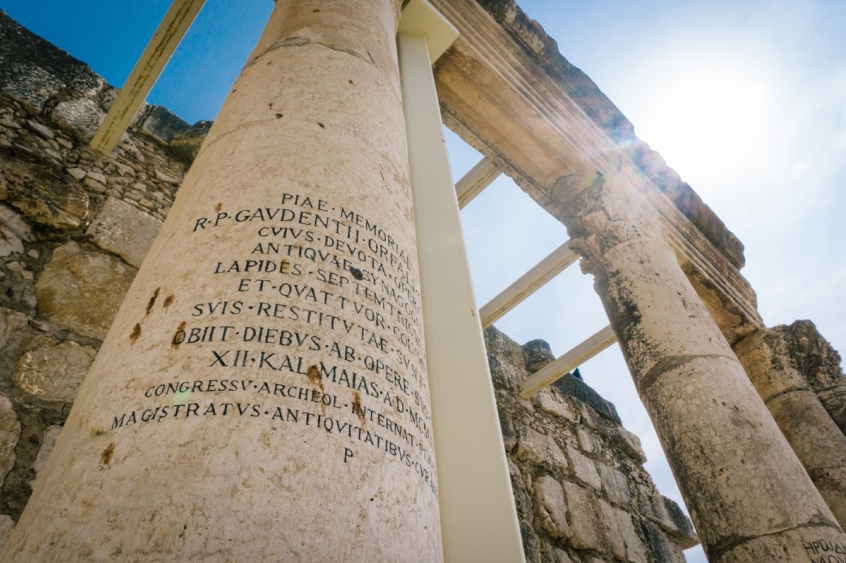
At the time of Jesus the town of Capernaum had not been in existence for a long time. It would have had some 1,000 to 1,500 inhabitants, among whom were Romans as well as Jews. The town was not destroyed during the Jewish rebellions in 70 and 132 AD, and from the second century AD it began to develop into a site of Christian pilgrimage, despite being hit by massive earthquakes in the fourth and seventh century.
Capernaum was only abandoned around the tenth century AD, and in 1866 the British Captain Charles Wilson identified the ruins as those of Capernaum. Few places in Israel have since been excavated as thoroughly as Capernaum. A large bath house from the second or third century is one of the testimonies to the presence of Romans in the town.
The synagogue
The synagogue in Capernaum has always been visible above ground and was already known to Wilson. The building sits on an artificial hill, overlooking the surrounding area. However, the present synagogue of white limestone does not date from New Testament times, but from the fourth or fifth century AD, as evidenced by the coins and pottery found in it.
Yet underneath this white synagogue, the remains of an older building were found. This was probably also a synagogue, although little more is left of it than remnants of black basalt walls dating back to the first century AD or even a little earlier. Because of Luke 7:1-10 this building is also referred to as 'the Synagogue of the Centurion'. Apart from its location, little would indicate that it is indeed a synagogue. The building was quite large, 19 by 25 metres, and the walls were up to a meter thick.
Peter's house
In the centre of the old town, some 30 metres to the south of the synagogue and equally far from Lake Galilee, are the remains of a housing block from the first century. Originally it consisted of typical small fishing houses such as one would expect in this port. Tradition says that one of the houses in this block was the home of the apostle Peter.
This house probably dates from around the time of Jesus' birth. Originally just a simple dwelling, in the second half of the first century it was thoroughly renovated. One of the rooms became remarkably big, about 7 by 6.5 metres. Its floor and walls were rendered with thick plaster, something unique in Capernaum and thus indicating a special treatment. In this room archaeologists did not find the usual fragments of pottery, but rather remains of oil lamps.
What was it that made this house and its development special? On the plaster we find graffiti from later times, mainly in Greek but also in Aramaic, Latin and Syriac. The word 'God' is among the scrawlings. It is said that the name 'Peter' occurs twice.
Pilgrims
The fourth-century pilgrim Egeria claims that she had visited the home of Peter in Capernaum; in her travelogue she writes: "In Capernaum is the home of the Prince of the Apostles, turned into a church but with the original walls retained. Here the Lord healed a crippled man."
Archaeologists have concluded that at the time of Egeria. there was around the original house a rectangular wall of about 27 metres long and almost as wide. It seems that the simple house had been turned into a kind of church. (In Rome there are also ordinary houses beneath many of the old churches.)
Around the year 570 AD a later pilgrim reports that the 'House of Peter' had been replaced by a large church, a basilica. This claim too fits with the archaeological data, because on top of the original church there is an octagonal church built in the fifth century. Already in 614 AD, however, this building was destroyed as the Persians invaded Galilee and left a trail of devastation.
Evaluation
So how do we evaluate claims that we can identify the 'House of Peter'? It seems that very early on the followers of Jesus regarded this first-century building as very special. This makes it likely that there was a continuous tradition that Peter had lived here. This is in contrast to many other 'holy places' in Israel where no continuous tradition exists and which were often only identified at the time of Emperor Constantine in the fourth century.
Of course, in this case there is no scholarly proof that the tradition is correct and that this simple house, which was first converted into a church hall and then into a full-blown church, goes back to Peter himself. On the other hand, there are no convincing reasons to doubt the traditions. It is therefore entirely possible that what we do indeed have is the House of Peter.
Is this then a proof for the existence of Jesus? Maybe indirectly. Peter, this simple fisherman from Capernaum, would have remained unknown if he had not connected his life and work with that of Jesus of Nazareth, the Messiah of Israel. The fact that Christians made pilgrimage to this house is an indication that Jesus may have lived there. But beyond that, we can say no more and no less.
Rev Dr Pieter J. Lalleman teaches the Bible at Spurgeon's College; see here for his recent books.













